New York Theatre Ballet performs a new work and a classic at the Jacob’s Pillow Dance Festival.
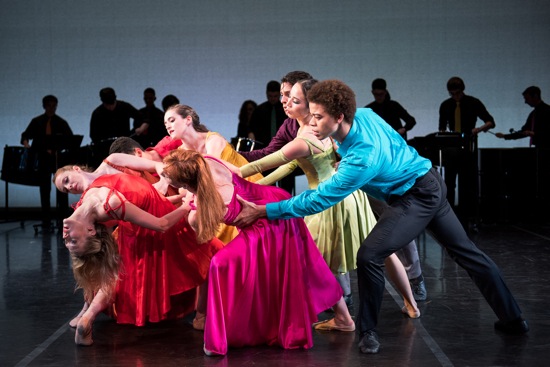
New York Theatre Ballet in Song Before Spring by Zhong-Jing Fang and Steven Melendez. Clockwise from R: Melendez, Amanda Treiber, Elena Zahlmann, Carmella Lauer, Daniel Salas, Alexis Branagan, Joshua Andino-Nieto, Mayu Oguri, Photo: Cherylynn Tsushima
Young choreographers are usually advised to start out “small.” You know, try their wings. Diana Byer, the artistic director of the fine little New York Theatre Ballet, took the opposite tack. According to an interview with Steven Melendez, a dancer in NYTB, and Zhong-Jing Fang, a member of American Ballet Theatre’s corps de ballet, Byer put them together to co-choreograph a new work and chose the music for it: Philip Glass’s Piano Etudes, Nos. 1-10, slightly re-ordered and played by New York University’s ten-person Steel Drum Ensemble (director: Josh Quillen). Running time: 48 minutes. That the resulting piece, Song Before Spring, works as well as it does is something of a triumph.
I missed the piece’s premiere at New York Live Arts in February, but saw it in Jacob’s Pillow’s Doris Duke Theatre this first August week, with its score played live. It’s a big, vivid, dramatic, occasionally perplexing piece that, toward the end, strains to fill Glass’s ongoing music. You want both to applaud it and calm it down so you can ask it a few questions.
In the effective opening, members of the Steel Drum Ensemble walk to their upstage lineup at a moderate pace, silhouetted against a blue-lit backdrop. Wearing black, even when illuminated, they take little attention away from the dancing, even as they play their steel pans (plus several drums) with terrific rhythmic acuity (no conductor). The sound is remarkable.
Choreographing what I gather was a first piece for both Melendez and Fang, they clearly had a narrative (or narratives) in mind. Adhering to the music’s sectional structure, they developed ideas that don’t always cross the boundaries between etudes, so the effect is of a sprawling saga, like one of those novels that weaves the stories of several families together through alternating chapters.
We can tell from the outset that this is a troubled community. The dancers, standing with their backs to us, begin a series of staccato moves—flipping a hand out, arching backward, etc. They’re not in unison. One of them (Mayu Oguri) is seated, which invites us to consider her as different in some way. Two men eventually help her up. This kind of assistance happens often and introduces a theme that runs through the piece: these people are concerned about one another. Often a dancer (usually a man) puts an arm protectively around another (usually a woman) and leads her away. Sometimes one carries another as if he/she were a tired child. A stranger event: one person leans his/her forehead against another’s chest and waits for what will ensue.
There are private encounters. Joshua Andino-Nieto and Daniel Salas embark on a demanding, intricately involved duet with acrobatic maneuvers (one flipping the other into a back somersault, say); their tangles could be combative or just a bit of friendly roughhousing, but there’s nothing convivial about Salas helping Andino-Nieto and then more or less dragging him away by the neck. Amanda Treiber and Alexis Branagan (delightfully buoyant in this) dance at each other in a playful, conversational, girlfriendish way.
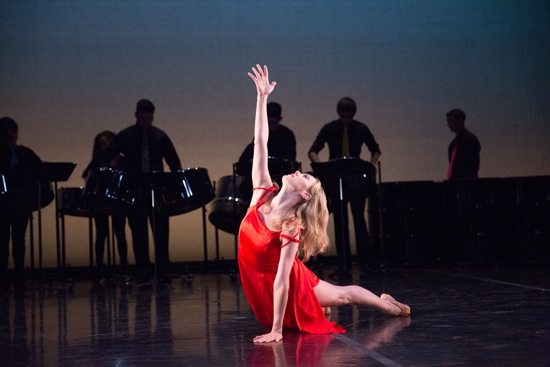
Elena Zahlmann in Song Before Spring. At back: Members of New York University’s Steel Drum Ensemble. Photo: Hyim Heron
Some characters in this story reveal themselves in heavily emotional solos. The one performed by Melendez is the most nuanced of these; he frequently curls in, clutching himself as if in pain, but he also sees something offstage that affects him, and seems, as he kicks and twists, to be struggling to express (or control) a barrage of feelings. Elena Zahlmann is dragged in by the men, dumped, and left alone on the floor. That she wears a short red satin dress, and her hair hangs loose brands her as the village adulteress (or someone in disgrace); she dances how deeply unhappy she is and stares at the audience as if to ask our help. (Later in the dance, she has sloughed off that identity and is again one with the group).
Ignoring one another or helping those in need, clustering to watch or dancing exuberantly (with few stringently balletic steps beyond leaps and arabesques), the performers are fully engaged in the mood of whatever they are doing and doing it extremely well. There’s almost always something of interest to watch. In certain ways, the elusiveness of the drama is interesting in itself—as if we were seeing it through veils, but that can also be troublesomely puzzling. Why, for instance, does Oguri appear briefly wearing the black jacket that, I think, belonged to Salas, as if doing so were of no consequence?
Given the title, I understand why the dancers eventually exchange their mostly monotone clothes (costumes by Sylvia Taalson Nolan) for brightly colored shirts and dresses: spring has come! But why do Carmella Lauer, Branagan, Oguri, and Zahlmann cluster around Treiber and garb her onstage in a deep pink gown that’s longer than anyone else’s? She’s featured prominently throughout; what is she being prepared for now? What does it mean that Branagan stands on Salas’s chest, gazing around while he lies supine with his legs in the air, and Andino-Nieto lifts Treiber?
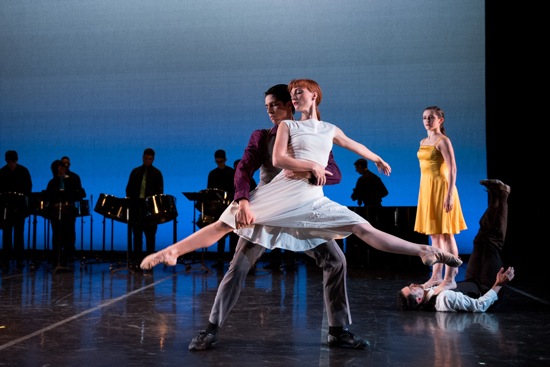
Song Before Spring. L: Amanda Treiber and Joshua Andino-Nieto. R: Alexis Branagan and Daniel Salas: Photo: Cherylynn Tsushima
There’s a kind of energy in this dance as a whole that’s endearing, as if choreographers Melendez, and Fang had a plethora of good ideas they wanted to try out. For a few seconds, women form a chain by sitting within one another’s slightly spread legs; the men do the same. Nice, but what does it tell us? Or lead to?
Cavils aside, congratulations are in order. As a maiden voyage, Song Before Spring is an accomplishment.
The NYTB closed its Pillow program with a masterwork that has been in its repertory for some time: Antony Tudor’s 1937 Dark Elegies, as staged by Donald Mahler. The Doris Duke isn’t the ideal place to see this spare, heart-wrenching piece; the dancers perform in front of a blue-green cyclorama, rather than Nadia Benois’ two original seascapes, which reinforced the memory of death by drowning of which the beautiful music—Gustav Mahler’s Kindertotenlieder (Songs on the Death of Children)—tells. Too, the space is so intimate that baritone Darren Chase can’t be viewed (at least from my seat) as truly part of the community (he is costumed like the male dancers); he stands over to one side in front of the proscenium with Michael Scales, who plays the reduced score for piano.
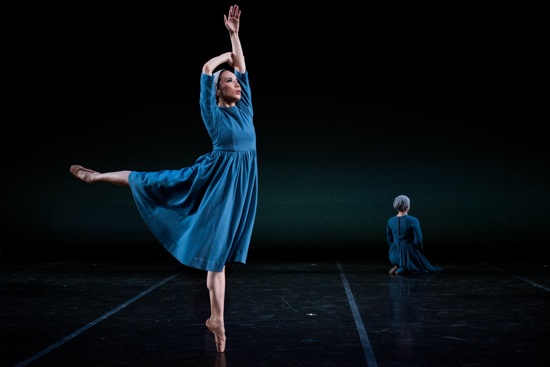
Mayu Oguri in Antony Tudor’s Dark Elegies. Photo: Cherylynn Tsushima
Never mind. Every time I see this spare, bleak ballet, I find new beauties in it, and the NYTB dancers perform it with admirable clarity and restraint, as well as a sense of how Tudor set his choreography to the music. Felix Rückert’s German lyrics tell of the families’ anguished responses to loss. A mother, entering her home, unconsciously looks at the place where her daughter ought to be. Another parent laments the fact that, with a storm brewing, the children should have been kept at home. They try to comfort themselves: “I often think: they have just gone out!/ Soon they will be coming home again!/ It’s a lovely day! O don’t be afraid!/ They are just taking a long walk.”
The twelve dancers are plainly clothed (costumes by Raymond Sovey, after Benois). The women wear head scarves, the men sweater vests. And their movements are constrained. As is often the case in Tudor’s ballets, they hold their arms down by their sides much of the time, but in Dark Elegies, the women sometimes walk gripping one forearm with their other hand, as if they were literally holding in their grief. The two women who perform solo lamentations and the one who dances with a partner wear pointe shoes (disguised so as not to stand out), which emphasizes the precariousness of their emotions: balance becomes a test of courage; they leave only a small, sharp footprint.
Simple dances in chains or in a circle stand for the everyday life they are trying to hold onto—their grave customs, their consideration for one another. But their feelings break out. Oguri suddenly collapses to the floor. Lauer rushes toward her partner (Melendez); jumps, arrow-straight, into his arms; and instantly crumples. This woman also lies down, imagining death, and Stephen Campanella and Andino-Nieto step up to help Melendez lift her, supine, as if onto a bier. Once set down again, she runs all the way around the outside of the circle that others have formed before continuing out of sight.
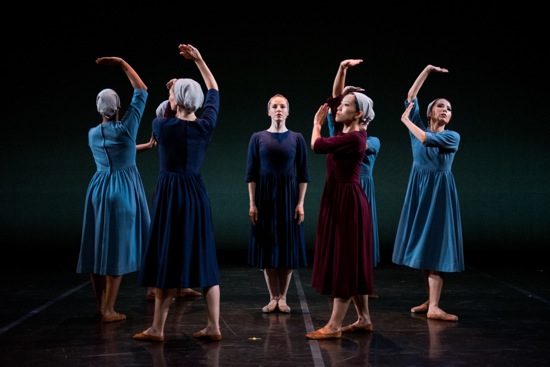
The women in Antony Tudor’s Dark Elegies. Center: Carmella Lauer. Photo: Cherylynn Tsushima
Tudor doesn’t give the dancers ballet’s rounded gestures. They angle their arms or open them wide; they clasp their hands. The women are slightly more stoic than the men. When Zahlmann finishes dancing to the fourth of five songs, she bows to each of the groups watching her, as if to ask their pardon for her outburst. The two sections featuring men are harsher and more distraught. Campanella jumps over and over; Andino-Nieto’s limbs and body seem to wrench him in different directions.
But all these people accept the tragedy as a part of life. And at the end of Scene Two, they formally join in pairs and walk out, leaving the woman who performed the first solo to trail behind, repeating her opening motif).
A small point in a very moving performance: Something seems very subtly askew in terms of timing about the way, Oguri executes that woman’s poignant hesitation in taking her next step (see for example Martine van Hamel enter in American Ballet Theatre’s long-ago production: https://www.youtube.com/watch?v=bOQR9xILcE0).
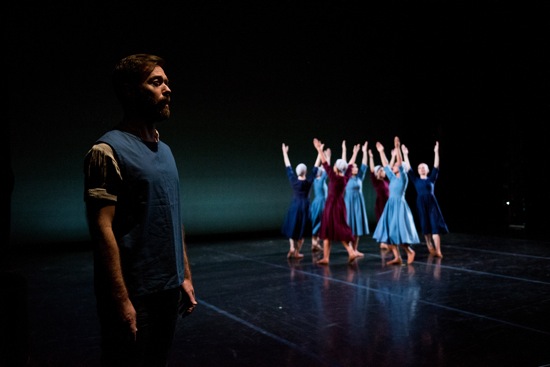
Singer Darren Chase and the women of Antony Tudor’s Dark Elegies. Photo: Cherylynn Tsushima
All the dancers capture the spirit of the original beautifully—sometimes a bit rough around the edges in the outbursts, but focused and committed. I appreciated Salas’s performance in the so-called Chorus; he seemed throughout to be alive to the moment and to those among whom he danced (Branigan, Giulia Farina, Akaya Kamei, Amanda Smith, and Treiber in addition to those mentioned).
A strange thing. For all the lush disorder of Song Before Spring, I could think back on it and imagine I could see an influence here and there of Tudor’s more compressed imagery and thematic intensity. Which reminds me: The program is aptly titled “Legends and Visionaries.”
